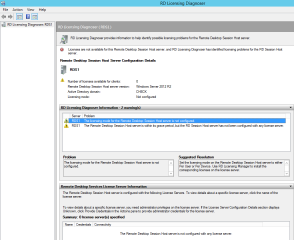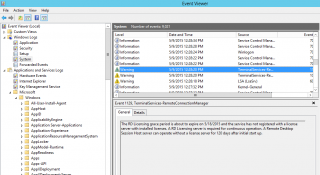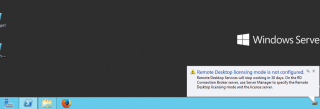Hello World,
We had a small issue on our test lab infrastructure. We were testing and implementing an RDS infrastructure. Because this was for test infrastructure, we didn’t implemented and installed an RDS Licensing server in our lab. By default, you can use the RDS infrastructure as a trial version up to 120 days.
Licensing Grace Period
Situation
In the lab, initially, we only installed some RDS server. Sometime later, we introduced additonal servers to test more and check scalability of the infrastructure. The test were sucessful and we left the test lab running.
Coming back later on the lab infrastructure, we needed to test some settings for RDS. When we tried to open a remoteapp application published through the web portal, we received the following error message :
The remote Session has been disconnected because there are no Remote Desktop Licensing Server available to provide a license
Click on Picture for Better Resolution
This error message was expected. Indeed, we didn’t installed the RD Licensing server in the test lab. The challenge here is this was affecting some of the users and the other users were connected normally and could start their remoteapp session…
So, some machines were still in the grace period, some others were not anymore. We had to identify which machines had reached the grace period
Identify the machines with grace period reached
RD Licensing Diagnoser
Actually, this is quite easy to perform. Microsoft provides the RD Licensing Diagnoser console which can provide information about which server is within or outside the grace period.
To access the tool, you open your Server Manager, click on Tools and select Terminal Services > RD Licensing Diagnoser
Click on Picture for better Resolution
In the RD Licensing Diagnoser console, you can gather the information about the fact that no RD Licensing server has been installed. You also also get the information about the fact that your are still in the grace period (or outside the grace period) through the tool
Click on Picture for better Resolution
Event Viewer
Another way to check this is simply to open the event viewer and you will get the information in the system events about the fact that your trial period has expired. You can look for event id 1128 and 1069. They will confirm the fact that you have reached the grace period on that RDS host server.
Click on Picture for better Resolution
Click on Picture for better Resolution
The RDS Host Server will also write an event log when you are about to reach the grace period. In the System logs, you can try to locate the event id 1129 or configure an action to be performed when event id 1129 is written in the logs…
Click on Picture for better Resolution
Balloon information
Finally, another way (more visual) to see information about your grace period is simply to read the information on the balloon that would appear at logon time on your system. This is probably the most efficient way to know the status of your grace period.
As you can see on the screenshot below, the balloon provide pertinent information. Number of days before grace period expires is displayed in the balloon warning utility (and not in the diagnoser console)
Click on Picture for better Resolution
The small issue with the balloon info is that the information appears time to time or you do not have time to read it because it didn’t catch your attention fast enough. However, note that you can display the balloon on demand (this is cool hein !).
The balloon grace period is simply a scheduled task that you can find under \Microsoft\Windows\termsrv\licensing in the task scheduler management console that will run at logon for any user on the system.
Click on Picture for better Resolution
If you open the task scheduler, locate the task ans select run now, the balloon will be displayed to you.
An even easier way to display the balloon info is to run from a command line the following :
- tlsbtn.exe
This is actually the exe file that’s called by the task scheduler.
Final Notes
Using all these tools, we have been able to identify the problematic RDS Host servers and we have simply removed the role on these ones. The best way to identify your expired RDS Host servers (when no licensing servers have been configured) is the tlsbtn.exe utility. Whenever you need the info about the licensing status, run the utility and you will have it
Hope you enjoyed this short post.
Till next time
See ya








